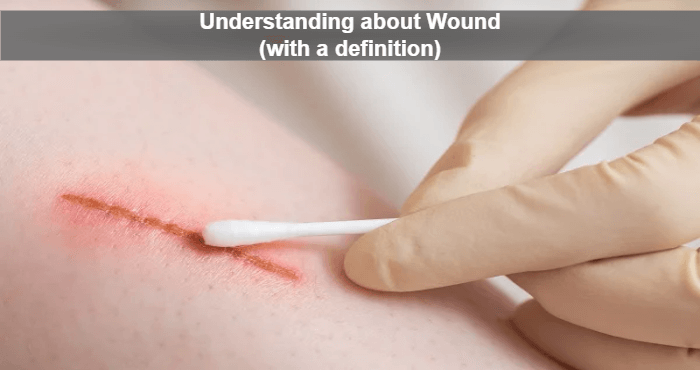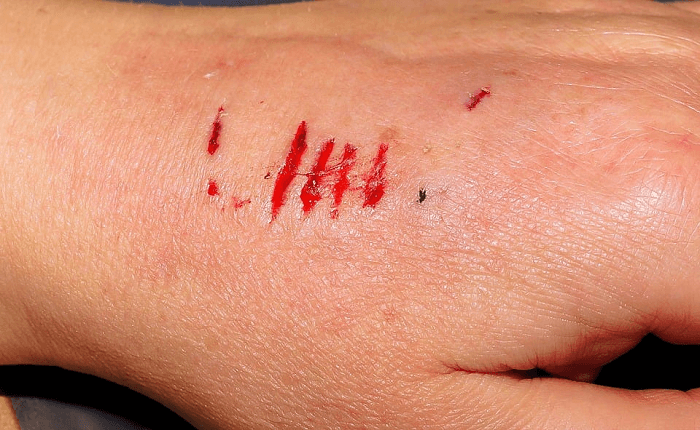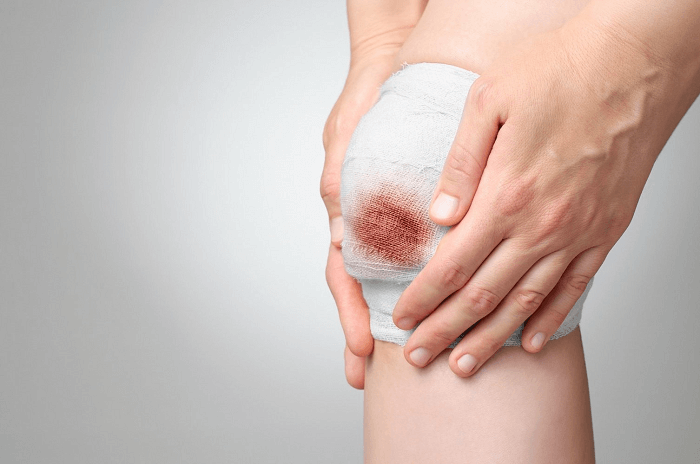Wound Definition
The injuries that occur on the body of a living being due to the rupturing of skin and body tissues are known as a wound. The term 'wound' may also be used as a verb for when the injury is inflicted upon someone (literal or figurative). Some examples of wounds are cuts, scrapes, and punctured skin.

Wounds on the skin may occur due to several uncertain instances such as falling, violence, accident, surgery, or even through the sharp edges of the paper. The extent of the wound or injury depends on how much tissue damage is inflicted on the skin. Based on the mode of wound production, the wounds are divided into two notable categories. These categories are closed and open wounds.
Closed Wounds
The injuries that are not exposed to the surroundings are called closed wounds. The bright side of a closed wound is that it often heals without getting infected by contaminants. On the other hand, the downside of a closed wound is that a person's limb may be damaged if the wound severely affects the internal muscles and bones. For example- if a person falls down the stairs and his head first touches the surface or is hit on the head with a blunt object, the skin covering the head may not always tear. However, this blunt force can sometimes cause serious injury to the brain and even cause a stroke.
The intensity of these wounds depends upon the force used to inflict violence on the epidermis. Certainly, by increasing the force applied in violence, the extent of tissue damage to the membrane will also increase. The skull is covered with soft tissues.
Therefore, even a small blow can irritate these tissues and cause skin injury due to the bursting of blood vessels inside the head. The underlying tissues in the body that can be severely damaged due to violence are blood vessels, bones, nerves, joints, and muscles.
Wounds of any kind could be discomforting. Therefore, it is better to know what to expect if a trauma results in a closed wound. Some of the complications associated with closed wounds are given below:
- Closed wounds can get worse and can cause heavy bleeding, nerve injuries, big bruises, organ damage, and bone dislocation.
- The most severe condition that could occur due to a closed wound is compartment syndrome. It is a condition where the victim experiences severe pains when the blood pressure at a particular part of the body rises dangerously. Additionally, the blood flow at some significant parts of the body may get decreased, due to which oxygen and other nutrients might not be able to travel through the blood vessels. Fasciotomy (surgery) is a procedure that is recommended by healthcare specialists as a treatment for compartment syndrome.
In most critical cases of compartment syndrome, the affected limb needs to be removed due to permanent paralyzation.
Types of Closed Wounds
The following are three major types of closed wounds:
- Crush Injuries: Crush injuries occur due to the increased blood pressure in some parts of the body, such as fingers, when crushed or squeezed between two hard surfaces. Depending on the surface, size, and force of the trauma, the pain and wound can be minor, or that part can be completely clamped due to severe pressure. Some tissue damages caused by crush injuries are nerve injuries, bleeding, bruising, fracture, and infection. The symptoms of crush injuries are limb paralysis, numbness in the crushed limb, tingling sensation in the impacted limb, and severe pain. It is suggested to stop the bleeding by applying pressure to the clamped area and wrapping a bandage or wet cloth on it to treat the crush wounds/ injuries.
- Contusion: The wounds that appear due to the direct impact of external force and cause damage to the skin tissues by excess pressure are known as contusions. These wounds or bruises mainly occur on the body of children because their skin is softer than adults, and they usually get injured while playing.
Contusions are minor injuries that can heal quickly. However, severe contusions can be caused if the skin is struck repeatedly with a blunt object or if a person falls on a hard surface. The signs of a contusion are swelling and bluish discoloration of the skin, stiffness in the affected area, and in some cases, a lump formed over the wound due to excessive blood collection.
- Hematoma: When the pool of blood gets collected inside the wounded part of the skin and results in the formation of a lump, this wound is known as a hematoma. Hematomas are considered serious injuries and can be harmful if they are big enough.
Depending on the part of the body where the trauma occurred, hematomas appear from small to big forms deep inside the skin. If the hematomas grow bigger than they are supposed to, they can cause problems in the supply of oxygen and blood, leading to a life-threatening condition known as shock. The skin near the hematoma turns into a dark red patch which could be the result of damaged soft tissues. Other hematoma symptoms are pain, swelling, and softness around the discolored area. Traumas that result in hematomas are head wounds, bone fractures, car accidents, and aneurysms.
Precautions and Treatments for Dealing with Closed Wounds
- The first step in dealing with a closed wound is to control the pain and minimize the bleeding and swelling.
- By using ice packs, applying pressure, elevation, and disenabling the affected limb, the closed wound can be handled to some extent.
- In the case of compartment syndrome, the pressure in the limb could be reduced by minor surgical cuts made by a physician through the bandage.
- The wound may be covered with a sterile dressing to reduce swelling and prevent pressure build-up on the wound.
- Fractures can be detected by using X-ray machines, and if the fractures are confirmed, plaster casts can be used to provide stiffness to the damaged bones.
Open Wounds
The wounds that materialize due to the rupturing in the skin, due to which the internal tissues are uncovered to the surrounding, are known as open wounds. The skin plays an important role in protecting the internal organs and tissues of the body from getting infected.

While playing, minor cuts and scrapes are considered acceptable and can be easily cleaned and treated at home. However, the wounds that occur due to the rupturing of the skin might require immediate medical attention.
If a cut is large, it can serve as the entrance to the air and germs present in it. The drying and cooling impacts of air can further damage the wound. For example- when a wound is made on the skin while using a sharp knife and needle, the tissues often get cleanly divided, and the wound can be treated by applying ointment. Notably, open wounds can be critical when the affected limb is made up of soft tissues.
Types of Open Wounds
There are many forms of wounds that are caused by the breaking of the skin. Some of the main categories of these wounds are given below:
- Puncture Wounds: The wounds that are caused when sharp objects such as a nail or a needle are passed through the skin are known as puncture wounds. Puncture wounds are mostly caused by animal bites and can be stretched through deeper tissue layers. If the wound stretches about an inch inside the skin, stitches might be required to control the damage. Metal punctures and animal bites may result in infection and other diseases such as rabies, trichinosis, blastomycosis, and so on if the wound is not treated immediately. It is because rusted metal and animal bites can be infectious.
- Laceration: A deep cut due to which the skin gets torn and the prime tissues might also get harmed is known as a laceration. In the laceration, the skin is only split open and not torn away from the body. Some examples of lacerations are cut on the finger by a knife or glass. If the lacerations are deeper than normal, they can get fatal. Lacerations can be categorized into two types: stretched lacerations and perforated lacerations.
- Stretched lacerations- The lacerations that are caused by blunt and heavy objects which result in overstretching of skin are called stretched lacerations.
- Perforated lacerations- The lacerations caused by sharp objects that can penetrate into the skin easily are called perforated lacerations.
If the lacerations are deep and the cut continues to bleed, the person should consult with a medical professional as soon as possible.
- Avulsion: The condition when the bone or ligament gets detached from the actual body part is known as avulsion. The avulsion occurs when a ligament or tendon gets suddenly pulled away from the bone. During avulsion, the internal muscle and bone tissues often get exposed. For example- if a limp gets caught under a heavy piece of machinery, this situation may lead to avulsion. Avulsions are usually caused by severe trauma. When the bone is moved one way during voluntary actions such as exercise and dancing while the tendon or ligaments is pulled on the other side, this may also result in an avulsion. Phlebectomy is the avulsion surgery in which the physician cleanly removes the varicose veins from the body by performing it under local anesthesia.
- Burn Wounds: The wounds that are caused due to the exposure of skin tissues to harmful chemicals such as acids, electric current, laser beam, harmful radiation, and excessive heat are known as burn wounds. Minor burn injuries, such as those caused during cooking, can be treated at home with antiseptic and cold water. Major burn wounds often require instantaneous medical attention. The full extent of damage caused by these burns is confirmed only after 2-3 days.
These wounds are divided into four major categories, as given below:
- Superficial or first-degree burns- When the person gets first-degree burns, only the epidermis of the skin is affected. The burnt area appears to be red and dry, and instances of pain are common. Mild sunburns are the most common example of first-degree burns. The emergence of scars is uncommon in first-degree burns. Putting slight pressure on the wound with an ice pack and applying petroleum jelly can help in relieving pain, and the wound gets healed quickly.
- Partial thickness or second-degree burns- In this case, both the uppermost layer of the skin, the epidermis, and the second layer, the dermis, get burnt. These are known to be the most common type of burns. Second-degree burns can either be mild or moderate. Scars can be caused by severe second-degree burns. In appearance, the burnt skin looks shiny, wet, and discolored in an irregular pattern. These burns are quite painful and itchy when touched. A common example of second-degree burn is a blister formed through scald burns. These burns take from 1-3 weeks to heal completely and leave scars after the healing process is completed.
- Full-thickness or third-degree burns- Third-degree burns completely destroy both the upper layers of skin and the damage is extended towards the third layer of skin as well. The burnt area appears waxy, stiff, and discolored. Along with the various layers of skin, subcutaneous tissues are also damaged by third-degree burns. Since nerve endings in the damaged area are destroyed, numbness is commonly experienced after some time of the trauma. In these types of wounds or damage, skin grafts are typically used for healing. A skin graft is a skin transplant procedure that is performed by removing skin from an unaffected area of the body and using it to cover the burned area.
- Fourth-degree burns- Along with the skin, tissues, muscles, nerves, ligaments, and tendons may also get affected by fourth-degree burns. Numbness in the burnt area is one of the symptoms of these burns. Some of the causes of these burns are hot iron, oven, flames, building fires, and toxic chemicals. The skin on the affected area appears to be charred and white. Also, in some cases of burns, the internal tissues, such as muscles and bones, can get exposed. Fourth-degree burns are not painful as the sensation in nerves gets dissipated.
Knowledge and awareness of the types of burns are important in treating burn wounds carefully.
Precautions and Treatments for Dealing with Open Wounds

- We should always clean the cuts after washing our hands to prevent any kind of infection.
- Minor cuts and scrapes do not bleed for a long time. However, if the bleeding continues, compress the wound and elevate the limb until the bleeding stops from the cut.
- The wound should be cleaned by using a clean, wet cloth or cotton. To minimize the risk of infection, a person should keep the injured area under running water. It is essential to keep any dirt away from entering the wound.
- Apply a layer of antiseptic or petroleum jelly on the wound so that the wound heals faster. Do not use ointments that may cause allergies.
- Cover the wound with a bandage or gauze if the cut is moderate or can bleed if left exposed. Leave it uncovered if the wound is just a scratch or scrape.
Conclusion
An injury to the body that can damage the integrity of biological tissues, including skin, mucous membranes, and organ tissues, is called a wound. In the case of any wound, it is important to seek early wound care to prevent major infectious diseases in the future.
|



 For Videos Join Our Youtube Channel: Join Now
For Videos Join Our Youtube Channel: Join Now










